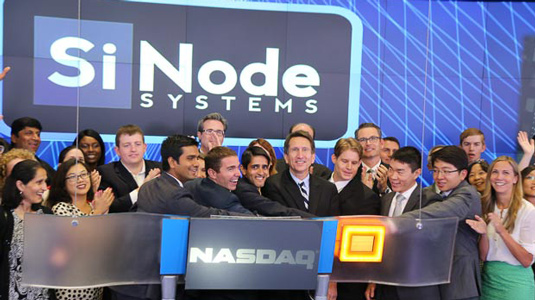SiNode Rings a Bell
Northwestern startup caps off a lucrative summer by ringing NASDAQ’s closing bell

Standing in the heart of Times Square, all six founding members of SiNode Systems rang the NASDAQ’s closing bell Friday, ending a whirlwind summer that saw the lithium-battery tech startup win nearly $1 million in prize money.
“We are from Chicago,” said CEO Samir Mayekar (Kellogg ’13). “And we develop advanced energy materials to power human innovation.”
SiNode Systems is made up of Northwestern alumni and graduate students: Cary Hayner and Joshua Lau, alumni of the McCormick School of Engineering and Applied Science, and McCormick graduate student Thomas Yu, as well as Mayekar, Nishit Mehta, and Guy Peterson of the Kellogg School of Management.
SiNode’s dedication to innovation — and the end of asking servers to charge dying smartphones — earned the team first place in the 2013 Rice Business Plan Competition, the world’s richest and largest graduate-level business competition. SiNode received a record $911,400 in cash, services and funding in May.
SiNode is the second Northwestern team to win the Rice competition in as many years, with NuMat Technologies winning in 2012. SiNode also followed up NuMat in June with a victory in the second annual National Clean Energy Business Plan Competition, sponsored by the U.S. Department of Energy.
SiNode also won the Cleantech Open’s north-central regional competition earlier this year in San Jose.
Scope equals success
The key to SiNode’s success? The team’s scope, said Michael Marasco, director of McCormick’s Farley Center for Entrepreneurship and Innovation. Marasco taught the NUvention: Energy course that asked SiNode and other teams to build a business plan based on a revolutionary battery material developed by Harold Kung, professor of chemical and biological engineering at McCormick and the inventor of the singular SiNode material.
The material is a composite of silicone and graphene — a carbon-derived substance whose discovery was recognized with the 2010 Nobel Prize in physics — that will allow lithium-ion batteries to charge up to 10 times faster and hold a charge for days.
“We’d worked with Dr. Kung’s technology in this class for the previous two years, but those teams didn’t see possibilities as big as this one did,” said Marasco of SiNode. “They thought outside the box, saw how it could be a business, and aggressively tried to get it traction.”
A collaborative, interdisciplinary curriculum developed by the Farley Center, McCormick, Kellogg, the School of Law, and the Weinberg College of Arts and Sciences, NUvention brings students from various fields together to create a viable tech business. The combination of McCormick and Kellogg students proved to be potent.
“What started as a class combining McCormick graduate students and Kellogg MBAs unlocked the entrepreneurial zeal in our team,” said Hayner.
Their winnings have allowed the group to move into their own lab in downtown Evanston and provided access to pro bono services. Commercial prototypes are expected by 2014, Mayekar said, with a hopeful market debut in 2015.